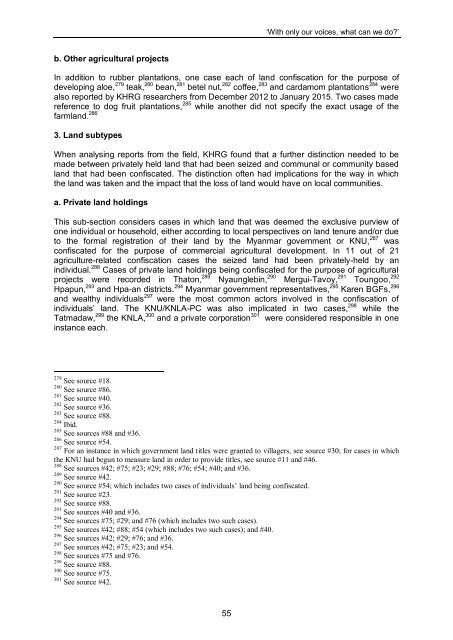With only our voices (English)
Create successful ePaper yourself
Turn your PDF publications into a flip-book with our unique Google optimized e-Paper software.
‘<strong>With</strong> <strong>only</strong> <strong>our</strong> <strong>voices</strong>, what can we do?’<br />
b. Other agricultural projects<br />
In addition to rubber plantations, one case each of land confiscation for the purpose of<br />
developing aloe, 279 teak, 280 bean, 281 betel nut, 282 coffee, 283 and cardamom plantations 284 were<br />
also reported by KHRG researchers from December 2012 to January 2015. Two cases made<br />
reference to dog fruit plantations, 285 while another did not specify the exact usage of the<br />
farmland. 286<br />
3. Land subtypes<br />
When analysing reports from the field, KHRG found that a further distinction needed to be<br />
made between privately held land that had been seized and communal or community based<br />
land that had been confiscated. The distinction often had implications for the way in which<br />
the land was taken and the impact that the loss of land would have on local communities.<br />
a. Private land holdings<br />
This sub-section considers cases in which land that was deemed the exclusive purview of<br />
one individual or household, either according to local perspectives on land tenure and/or due<br />
to the formal registration of their land by the Myanmar government or KNU, 287 was<br />
confiscated for the purpose of commercial agricultural development. In 11 out of 21<br />
agriculture-related confiscation cases the seized land had been privately-held by an<br />
individual. 288 Cases of private land holdings being confiscated for the purpose of agricultural<br />
projects were recorded in Thaton, 289 Nyaunglebin, 290 Mergui-Tavoy, 291 Toungoo, 292<br />
Hpapun, 293 and Hpa-an districts. 294 Myanmar government representatives, 295 Karen BGFs, 296<br />
and wealthy individuals 297 were the most common actors involved in the confiscation of<br />
individuals’ land. The KNU/KNLA-PC was also implicated in two cases, 298 while the<br />
Tatmadaw, 299 the KNLA, 300 and a private corporation 301 were considered responsible in one<br />
instance each.<br />
279 See s<strong>our</strong>ce #18.<br />
280 See s<strong>our</strong>ce #86.<br />
281 See s<strong>our</strong>ce #40.<br />
282 See s<strong>our</strong>ce #36.<br />
283 See s<strong>our</strong>ce #88.<br />
284 Ibid.<br />
285 See s<strong>our</strong>ces #88 and #36.<br />
286 See s<strong>our</strong>ce #54.<br />
287 For an instance in which government land titles were granted to villagers, see s<strong>our</strong>ce #30; for cases in which<br />
the KNU had begun to measure land in order to provide titles, see s<strong>our</strong>ce #11 and #46.<br />
288 See s<strong>our</strong>ces #42; #75; #23; #29; #88; #76; #54; #40; and #36.<br />
289 See s<strong>our</strong>ce #42.<br />
290 See s<strong>our</strong>ce #54; which includes two cases of individuals’ land being confiscated.<br />
291 See s<strong>our</strong>ce #23.<br />
292 See s<strong>our</strong>ce #88.<br />
293 See s<strong>our</strong>ces #40 and #36.<br />
294 See s<strong>our</strong>ces #75; #29; and #76 (which includes two such cases).<br />
295 See s<strong>our</strong>ces #42; #88; #54 (which includes two such cases); and #40.<br />
296 See s<strong>our</strong>ces #42; #29; #76; and #36.<br />
297 See s<strong>our</strong>ces #42; #75; #23; and #54.<br />
298 See s<strong>our</strong>ces #75 and #76.<br />
299 See s<strong>our</strong>ce #88.<br />
300 See s<strong>our</strong>ce #75.<br />
301 See s<strong>our</strong>ce #42.<br />
55


















